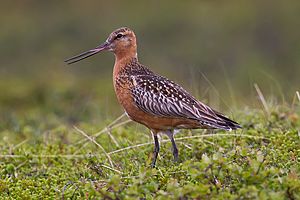Sandpiper facts for kids
Quick facts for kids Sandpipers |
|
|---|---|
 |
|
| Dunlin (Calidris alpina) | |
| Scientific classification | |
| Kingdom: | |
| Phylum: | |
| Class: | |
| Subclass: | |
| Infraclass: |
Neoaves
|
| Order: | |
| Suborder: |
Scolopaci
|
| Family: |
Scolopacidae
Rafinesque, 1815
|
Sandpipers are a big group of birds that live near water. They are also called shorebirds or waders. This family of birds is known as Scolopacidae. Many birds in this group are called sandpipers. Others have names like curlews and snipes. Most sandpipers eat tiny creatures found in mud or soil. They have different length beaks. This helps them find food in the same places without fighting over it.
Sandpipers have long bodies and long legs. They also have narrow wings. Most kinds have a thin beak. But their overall shape and size can be quite different. They are small to medium-sized birds. They can be from 12 to 66 cm (5 to 26 in) long. Their beaks are very sensitive. This helps them feel for food in the mud and sand. Sandpipers usually have plain feathers. Their colors are often brown, grey, or streaked. This helps them blend in with their surroundings. Some birds show brighter colors when it's time to breed.
Most sandpipers build their nests in open areas. They protect their homes with special flights in the air.
Contents
What Sandpipers Eat and How They Find Food
Sandpipers use four main ways to find food. Many species can use more than one method.
One way is by pecking at the ground. They might also probe the ground a little. This is common for birds in dry places. These areas do not have soft soil or mud.
The second way is the most common. They probe soft soils, muds, and sands. They look for small animals hidden there.
The third method is used by Tringa shanks. These birds run in shallow water. They keep their beaks under the water. They chase fish using both sight and touch.
The last method is used by phalaropes and some Calidris sandpipers. They peck at the water's surface. They are looking for small prey. A few sandpipers also eat plants. They might eat seeds and shoots, along with small creatures.
Life Cycle and Reproduction
Sandpipers usually lay three or four eggs. Their nest is often a simple dip in the open ground. It is barely lined with soft plants.
In some species, both parents take turns sitting on the eggs. They share this job in different ways. Some parents switch places in the morning and evening. This means they follow a 24-hour day rhythm. Other birds might sit on the nest for up to 24 hours. Then their partner takes over.
In species where only one parent sits on the eggs, that parent stays on the nest almost all night. During the warmest part of the day, they leave the nest for short times to eat.
The chicks hatch after about three weeks. They can walk and find their own food within a few hours. One parent or both parents guide and care for the young chicks.
Images for kids
-
The least sandpiper is the smallest species of sandpiper
-
Sandpipers spending the non-breeding season in Roebuck Bay, Western Australia
-
Bristle-thighed curlew (Numenius tahitiensis, right) and ruddy turnstones (Arenaria interpres)
-
Common snipe (Gallinago gallinago)
-
Greenshank (Tringa nebularia)
See also
 In Spanish: Escolopácidos para niños
In Spanish: Escolopácidos para niños









